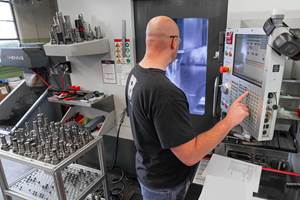Is Magnetic Workholding For You?
Holding metal parts with magnets is migrating from surface grinding to broader application in general metalworking processes, especially milling. Advances in magnetic technology are causing many shops to re-evaluate how they hang on to workpieces. Here’s a look at how magnets may be a viable workholding solution for your shop.
Share




The metalworking craft is an interesting blend of science and art. The tools available to the machinist represent the science. The art is in their application.
The science behind workholding in the metalworking shop is fairly basic. Hang on to the blank, casting or forging to be machined, with sufficient grip to allow metalworking processes such as milling, turning, drilling or grinding to be performed.
The metalworker’s art in workholding is the myriad ways that can be used to accomplish the basic science. Traditionally most workholding methods involve many variations of mechanically securing the workpiece.
Magnets have entered the workholding fray in recent years as an alternative to mechanically holding workpieces for machining and for holding workholders such as vises and fixtures on the machine tool table. Long an accepted method of workholding in surface grinding applications, magnets are finding acceptance in general machine shops looking to reduce setup, increase access to the five sides of a workpiece and simplify their approach to workholding.
Basics Of Magnets
Most of us remember from our general science class that magnets attract ferrous materials. Magnets have a north and south pole across which flows magnetic energy called flux.
In the classic experiment using iron filings, one can actually see, by the arrangement of the filings, that the magnetic flux flows in roughly parallel arcs between the two poles. Basically magnets work by inducing polarity (magnetizing) into any ferrous material that connects across its poles. When a workpiece is placed across the poles of a magnet, the flux flows into it.
When placed in the magnet flux, ferrous components have poles that are opposite the polarity of the magnet. This is why they attract. Amplifying and controlling this flux is the key to applying magnets in a metalworking operation.
The attraction or “pull” of the magnet becomes stronger as the gap between the workpiece and the magnet closes. Smooth surfaced workpieces are more tightly held than rough surfaced. The strength of the magnetic attraction is a function of how much magnetic flux can be induced into the workpiece.
Some materials are better conductors of magnetism than others. Annealed materials are best. Hardened materials don’t absorb flux as easily and tend to retain some magnetism when the magnetic workholder is switched off.
The magnetic workholder is constructed of a series of magnetic poles. In general the more of these poles that engage a given workpiece, the stronger the magnetic grip.
Magnets For Milling
According to Simon Barton, CEO of Alpha Workholding Solutions, Inc., one of the biggest hurdles to overcome in applying magnets to milling and general machining is fear. “It’s quite understandable,” he says. “The thought of a 50 horsepower milling machine plowing into a piece of steel, invisibly held only by magnetism, leaves most shop veterans petrified and ducking for cover.”
However, properly applied magnets will hold workpieces as well or, in many cases, better than mechanical clamps. Instantaneous clamping force of 12 tons per square foot is generated on these holders.
The magnetic system of choice for milling machine and machining center applications is called an electro-permanent magnet. As its name implies, this relatively new concept is a hybrid of electro-magnets and permanent magnets.
Electro magnets are not practical for machining operations because they require a continuous source of electric power to maintain magnetic attraction. Should power be interrupted, the electro-magnet loses its ability to hold the workpiece in which case the shop veteran is very wise to duck for cover.
Permanent magnets offer the advantage of portability and fail-safe operation. Most industrial permanent magnets sit within a carrier. Alignment of the poles determines the state of the magnet (whether it is on or off). In operation, these poles are physically moved to activate and de-activate the permanent magnet.
As permanent magnets are scaled up to provide sufficient surface area to accommodate the demands of machining operations, the mechanical effort required to overcome magnetic friction when switching poles from on to off or back becomes too great. For light duty machining, these magnets are well applied because of their reliability and safety.
Electro-permanent magnets, in effect, use electricity to switch the poles, which allows these units to be larger and more powerful for metalworking applications. An electro-permanent workholder contains a number of steel poles, each alternating between north and south polarity. The number of poles depends on the size of the workholder.
These poles have two magnets sandwiched in between them. One is an electronically switchable permanent set and the other is a permanent set. These permanent sets are constantly polarized in one direction.
The switchable magnets have an electric coil around them and can be polarized in either a north or south direction by passing a current through the coil. When both sets of magnets have like polarity, they complement each other, and full magnetic power is achieved. When both sets have opposite polarity, they cancel each other out and the magnet surface is off.
Recent advances in magnetic materials have increased the power of magnets while reducing the size of the magnetic workholding unit. “The heart of the newer magnetic workholders is rare earth neodymium iron boron,” says John Powell, Ph.D., president of WEN technology (distributor for Eclipse Magnets). “Neodymium is at least five times more powerful than other materials that have been used in magnetic workholders.”
To operate one of these units, a workpiece is placed on the magnet, and a simple push button sends an electric current that actuates the magnet. Once the electro-permanent magnet is energized, it requires another electric jolt to de-energize it. Like a permanent magnet, this system is fail-safe and portable, making it ideal for machining applications.
Process Advantages
Consistent clamping pressure is one advantage of magnets. Magnets are either on or off. Unlike mechanical clamps and vises, there is no variation in how tight or loose the workpiece is held. It’s always held the same.
Full support of the workpiece surface is another plus for holding with magnets. When toe clamps are used around the periphery of a workpiece, there is virtually no effective method to secure the center area of the work. Unsupported areas of the workpiece can be induced to chatter causing the feeds and speeds of the cut to be reduced, increasing cycle time.
Magnets hold on the total contact area of a workpiece. Full support allows the machine to cut with less chatter potential and therefore faster. In addition, the lack of clamps around the periphery enables the machine to cut without interference. Programming is simplified, and time required to reposition hold down clamps is eliminated.
“Full access to the workpiece is a critical consideration for shops looking to increase their throughput,” says Dr. Powell. “Magnetic workholders can be set up with pole extensions, which are basically stand-offs, that raise the workpiece above the surface of the magnetic table. This enables through-holes to be drilled without damaging the magnet. Self shimming pole extensions allow contoured or even warped workpieces to be gripped over their full surface area without deflection.”
Setup and tear down speed are major considerations for most shops. With magnets installed on the machine table, like a sub plate, workpieces can be attached directly to the magnet surface. In addition, vises or other fixtures can be then attached to the machine without bolts, using the magnet. Set the vise on the magnet, using locating pins for repeatability or probe for location, push the magnet on switch, and the vise is clamped.
Using the magnet to support a vise or other workholding fixture allows shops to machine non-ferrous materials, which can be gripped conventionally in a ferrous vise or fixture, while taking advantage of the fast setup capabilities of the magnet.
Sticking Chips?
According to both Dr. Powell and Mr. Barton, the most common question from shops not familiar with magnetic workholding is about chip control. Technically, the top of a workpiece becomes magnetic if the flux extends through a cross section of the work.
Simple pole extenders control the flux penetration variable. It can be increased or decreased by physically spacing the work using stand-offs a prescribed distance. On some magnetic workholders, it can also be adjusted by controlling the magnetic pull of the table.
It’s For Turning Too
Magnetic chucks are also finding wider acceptance on turning applications. An example of accessibility using a magnetic chuck is turning a donut shaped disk. “To process this part on a conventional chuck,” says Dr. Powell, “you grip on either the OD or the ID. To turn all of the features, it’s necessary to stop the operation and re-chuck the part. With an electro-permanent magnetic chuck, the ID, OD and face of the disk can be turning without stopping the machine. It’s a big advantage in processing speed. Accuracy is better too because the part is handled once.”
Who Should “Magnetize”
Application of magnets in milling and turning as well as other general metalworking processes can be considered a step toward automation of the workholding process. It’s not a universal solution, but, properly applied, magnets can and do slash time and labor associated with workholder setup.
It’s a given that ferromagnetic materials are the workpieces of choice for magnetic workholding. While non-magnetic material applications can’t benefit directly from magnetic workholding, indirect benefits can be realized using magnets to hold workholders that hold the non-ferrous blanks.
Shops that process larger surface area workpieces such as flame cut steel plate are virtual no-brainers for magnetic workholding. Small workpieces are less successfully applied because they lack sufficient surface area. However, vises can hold smaller parts, and simply placing several vises on a magnetic workholder and pushing a button to secure all the vises at once is a time saver.
“The technology of practical magnetic workholding is now in place,” says Mr. Barton. “These magnetic workholders are manufactured in a variety of sizes, and the distances between poles are increasingly smaller, meaning the surface area requirements are shrinking. Overcoming the inertia for mechanical workholding is the primary barrier to wider application of magnetic workholding.”
Related Content
Custom Workholding Shaves Days From Medical Part Setup Times
Custom workholding enabled Resolve Surgical Technologies to place all sizes of one trauma part onto a single machine — and cut days from the setup times.
Read MoreMedical Shop Performs Lights-Out Production in Five-Axes
Moving to five-axis machining enabled this shop to dramatically reduce setup time and increase lights-out capacity, but success relied on the right combination of workholding and automation.
Read MoreParts and Programs: Setup for Success
Tips for program and work setups that can simplify adjustments and troubleshooting.
Read MoreCustom Workholding Principles to Live By
Workholding solutions can take on infinite forms and all would be correct to some degree. Follow these tips to help optimize custom workholding solutions.
Read MoreRead Next
Building Out a Foundation for Student Machinists
Autodesk and Haas have teamed up to produce an introductory course for students that covers the basics of CAD, CAM and CNC while providing them with a portfolio part.
Read More5 Rules of Thumb for Buying CNC Machine Tools
Use these tips to carefully plan your machine tool purchases and to avoid regretting your decision later.
Read MoreRegistration Now Open for the Precision Machining Technology Show (PMTS) 2025
The precision machining industry’s premier event returns to Cleveland, OH, April 1-3.
Read More













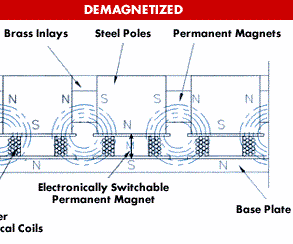



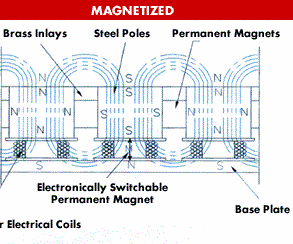
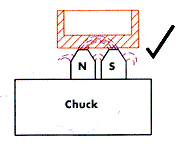

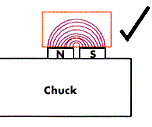
.jpg;width=860)







.jpg;maxWidth=300;quality=90)




